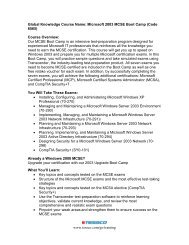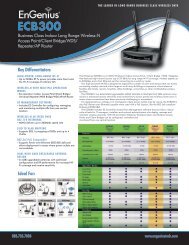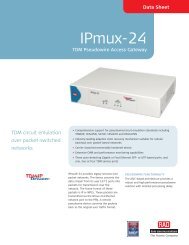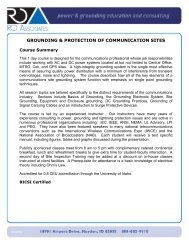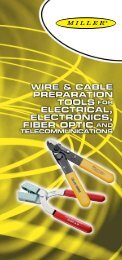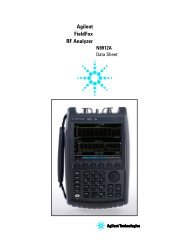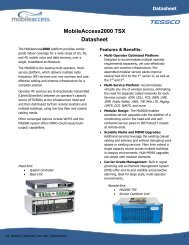Interference Hunting Course Overview - Tessco
Interference Hunting Course Overview - Tessco
Interference Hunting Course Overview - Tessco
You also want an ePaper? Increase the reach of your titles
YUMPU automatically turns print PDFs into web optimized ePapers that Google loves.
<strong>Interference</strong> <strong>Hunting</strong> <strong>Course</strong> <strong>Overview</strong><br />
<strong>Course</strong> Length 2 days<br />
<strong>Course</strong> Objectives This course is for anyone who is involved with interference hunting<br />
in radio services. It will provide theoretical and practical fundamentals needed to<br />
effectively identify and locate radio frequency interference issues in any band or<br />
network. It begins with an overview of basic RF principles, signal types, propagation<br />
and spectrum allocation.<br />
Practical applications include interference hunting tools, the use of monitoring<br />
receivers, spectrum analyzers and drive test tools. Methods of radiolocation (direction<br />
finding) and signal analysis will be demonstrated using live signal sources and handson<br />
exercises.<br />
Who should attend<br />
System Performance Engineers<br />
Anyone involved in interference hunting and spectrum clearing<br />
Civilian and military spectrum managers<br />
Regulatory agency field engineers<br />
Wireless field technicians and engineers<br />
Public Safety and government intelligence Officers<br />
How will you benefit<br />
General RF principles related to interference hunting<br />
Application of different interference hunting tools<br />
Spectral and signal analysis<br />
Direction finding principles and applications<br />
Best practices for identifying and resolving interference issues
COURSE OUTLINE<br />
General RF principles<br />
Frequency / wavelength (relationship between)<br />
Power / attenuation (how to measure, etc.)<br />
Measurement units (dBm, dBμV, conversions, etc.)<br />
Modulation vs. unmodulated signals<br />
Noise (including noise floor)<br />
Signal characteristics<br />
Bandwidth<br />
Analog modulation types (CW, AM, FM, etc.)<br />
Digital modulation types (FSK, QPSK, QAM, etc.)<br />
Propagation<br />
Propagation characteristics by frequency range<br />
Factors affecting propagation<br />
External signal sources<br />
Reflections / multipath<br />
Spectrum overview<br />
General overview of spectral allocations<br />
Technology specific overviews (US cellular bands, military, etc.)<br />
Setting References – Base lining<br />
Spectrum clearing/re-farming<br />
Researching spectral allocations / licensing<br />
Antennas<br />
Mechanics of coaxial connectors<br />
Preparing cables for connectors<br />
Installing connectors<br />
Basic principles of direction finding<br />
What is direction finding<br />
Uses of direction finding<br />
<strong>Overview</strong> / comparison of direction-finding methodologies<br />
Mapping/triangulation<br />
<strong>Overview</strong> of interference hunting tools<br />
Spectrum analyzers<br />
Monitoring receivers<br />
Drive test systems<br />
Antennas<br />
Basic spectral analysis<br />
Understanding and interpreting spectrum displays<br />
Understanding and interpreting waterfall diagrams (spectrograms)<br />
Other spectral analysis modes (persistence display, e.g.)<br />
Numerical measurements (use of markers/ lines)
COURSE OUTLINE Continued<br />
Radio <strong>Interference</strong> types<br />
Modulated vs. unmodulated sources<br />
Uncorrelated interference / noise floor issues<br />
Patterns in interference (time of day, reactive)<br />
<strong>Interference</strong> Types<br />
o Intermodulation<br />
o Harmonics<br />
o Spurious Emissions<br />
Recognizing interference issues<br />
Typical signs of interference<br />
Interpreting spectral issues<br />
Diagnosing interference using instruments<br />
Analyzing specific interference issues<br />
Harmonics / intermodulation<br />
Narrowband vs. wideband interference<br />
Use of demodulation / signal analysis<br />
Device-specific interference (e.g. jammers, BDAs, etc.)<br />
Long-term monitoring / recording<br />
Location of interfering signals<br />
Common transmitter and antenna types<br />
<strong>Interference</strong>-prone locations<br />
Use of drive-test / vehicle tools<br />
Use of handheld / portable tools<br />
Antennas and direction finding systems<br />
Resolving interference issues<br />
Determining type/location of interfeering device<br />
Communication with owners of interfering<br />
Understanding legal/regulatory issues and remedies<br />
Practical exercises<br />
Diagnosing and locating indoor interference<br />
Diagnosing and locating outdoor interference<br />
Handheld, on-foot interference hunting (“last 100 meters”)<br />
Source analysis (“last inch”)<br />
<strong>Interference</strong> hunting challenges



